#Orthopedic Ankle Support
Explore tagged Tumblr posts
Text
#Orthopedic Braces and Supports Market#Medical Braces and Supports#Foot and Ankle Brace#Orthopedic Knee Brace#Orthopedic Back Support#Orthopedic Ankle Support#Orthopedic Braces
0 notes
Text
The United States sports medicine market size reached US$ 2,643.1 Million in 2023. Looking forward, IMARC Group expects the market to reach US$ 3,662.3 Million by 2032, exhibiting a growth rate (CAGR) of 3.6% during 2024-2032. The market is experiencing steady growth driven by the growing emphasis on fitness and wellness, growing geriatric population striving to maintain an active lifestyle and continual advancements in medical procedures including minimally invasive surgical techniques and enhanced rehabilitation methods.
#United States Sports Medicine Market Report by Product (Body Reconstruction#Body Support and Recovery#Body Monitoring and Evaluation#Compression Clothing#Accessories)#Application (Knee Injuries#Shoulder Injuries#Foot & Ankle Injuries#Hip & Groin Injuries#Elbow & Wrist Injuries#Back & Spine Injuries#and Others)#End User (Hospitals#Orthopedic Specialty Clinics#Fitness and Training Centers#Ambulatory Surgery Centers (ASCs)#and Region 2024-2032
0 notes
Text
#Orthopedic Braces and Supports Market#Medical Braces and Supports#Foot and Ankle Brace#Orthopedic Knee Brace#Orthopedic Back Support#Orthopedic Ankle Support#Orthopedic Braces
0 notes
Text
Scarecrow Leg Observations/Headcanons
aka I thought about it too much and now it's everyone else's problem.



(important note: I am not in the medical field and I learned/looked up a lot of this with the help of Dr. Google)
The leg brace seems like a simple detail which can be overlooked in the larger design. On the surface, it's pretty straight forward: leg got damaged and now needs an orthopedic brace to function. This in and of itself is interesting since the artist undoubtedly referenced actual braces, specifically old ones, to fit Scarecrow's aesthetic:
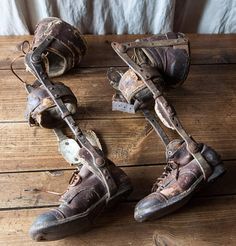

This is a running theme with him; he seems to favor old, antique items and will repair things (like the use of duct tape or zigzag stitching for tears on his costume) before replacing them, which fits an image of someone coming from a background of poverty. Not entirely important to the conversation, just an interesting aside.
There is official material which states his leg is "permanently broken", which is probably the easiest, most succinct way to state this issue, but it's not entirely an accurate way to put it. If a leg is considered broken beyond repair, it's likely to be amputated. Bones which don't heal correctly the first time can be broken again and realigned to heal properly, often through surgery with the use of pins, rods, plates, and/or screws. However, "permanently broken" could also be implying he has suffered irreparable nerve damage which affects the use of the leg (more on that in a moment). One possibility: The bones in Scarecrow's leg do not heal properly due to the severity of his fractures likely needing surgery. Unable to access such resources after his run-in with Croc, this results in a malunion. In his case, the misalignment could be subtle as there is no obvious bend or twist in his leg, but still causes problems which requires use of a brace.
Another possibility: Perhaps he is lucky and his leg does heal well. Maybe there's no malunion at all. Unfortunately, whether the bones mend together well or not, evidence strongly implies that it was broken seriously enough that it damaged his peroneal nerve, leading to muscle weakness and foot drop, which necessitates the use of the brace to function.
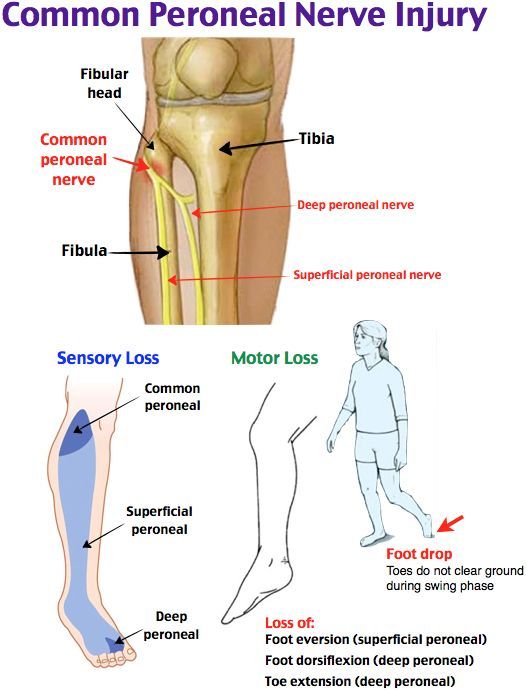
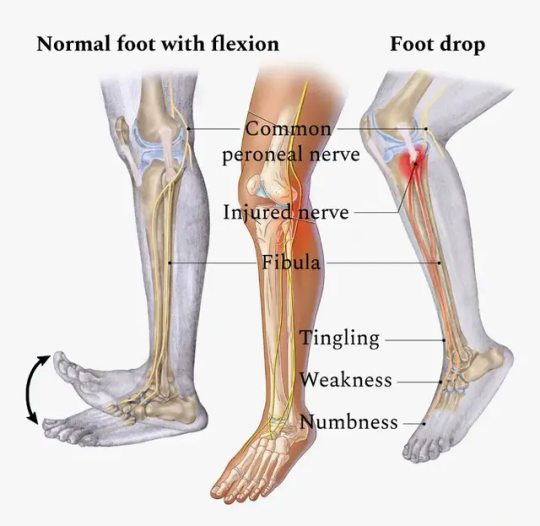

If you look closely, you can see there is additional support around Scarecrow's ankle that would otherwise prevent rotation of that joint. You can see this in the game when he circles Batman on the airship:
youtube
When he takes a step with his good leg, the foot remains more parallel to the floor. Compare that to the foot in the brace, where the toes point upward with each stride due to being in a fixed position. I feel this is a strong indication of him having lasting damage here (such as foot drop) and part of why the leg brace is vital to his mobility (and undoubtedly one of many reasons why he's so furious at Batman).
Something like this often has trickle down effects. Having to compensate for a weaker limb can throw the body off balance, especially if it's a leg. This can create joint and back pain outside of (or in addition to) the issues related to the initial trauma. Combined with the other things he has had to deal with, there is something to be said of Scarecrow's tenacity. He is very driven and ambitious, even if it's the pure, seething drive for vengeance which causes him to persevere. It's a quality one can admire. :)
The rambling ends here, thanks for reading. And an extra big thanks to a very special someone who, without their help, none of this would be possible...I'm of course talking about my guy KILLER CROC for going absolutely feral in those Asylum sewers, really gave Jonny here a spooky glow-up, am I right?

Pictured: Scarecrow regretting his fear toxin frivolity into the sewers.
#enjoy the rambling#jonathan crane#scarecrow#arkham scarecrow#not much going on here but there's some interesting tidbits to chew on
149 notes
·
View notes
Text
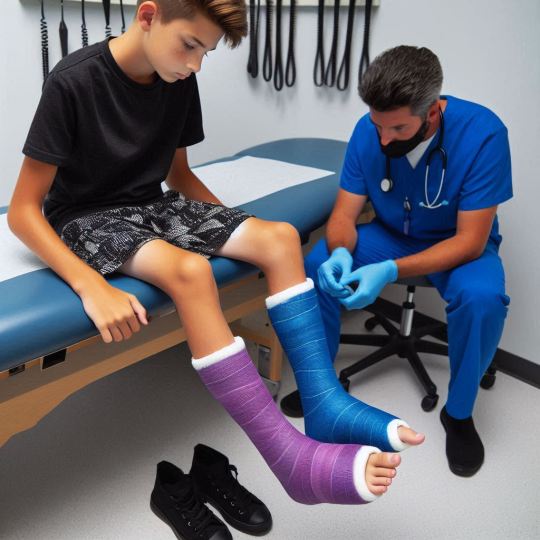
Chad sat on the edge of the padded table in the orthopedic rehab room, his legs dangling over the side, bare feet shifting nervously just above the floor. The room had that clinical scent—plaster, antiseptic, and a hint of something chemical—and a wall shelf stocked with rolls of colorful fiberglass. His eyes landed on a bright pink roll. Really?
“This is your first cast,” said Jake, the physical therapist, as he rolled in a metal cart loaded with supplies. “Pink on the left, blue for the right next week. We’ll switch up colors with each change—makes the process a little less boring.”
Chad raised an eyebrow. “Pink?”
Jake gave a friendly shrug, grinning. “You'd be surprised how many people go for it. Plus, if you're going to be stuck in casts for a while, you might as well go bold.”
Chad snorted. “Right. Might as well commit.”
He wasn’t exactly thrilled to be here. After months of physical therapy for his chronically tight Achilles tendons, this—serial casting—was his last stop before surgery became the only option. It felt a little like surrender. But he also knew his walking was off, his gait stiff, and his ankles barely gave him the range he needed. The casts would force the tendons to lengthen slowly, week by week, stretching him out in stages.
Jake knelt in front of him and began slipping a soft cast sock over his left foot and up to just below the knee. “We’ll keep this first one gentle,” he said. “Not too aggressive with the stretch. Just enough to start teaching the tendon where we want it to go.”
Chad nodded, watching Jake’s hands as he worked—methodical, experienced, calm. The pressure of the sock and padding was oddly soothing, even if Chad couldn’t quite relax. There was something surreal about sitting in a chair while someone essentially encased part of your body in hard, unyielding plastic.
Jake wrapped layers of soft cotton around the foot and calf, pausing occasionally to check pressure points and ensure comfort. “Let me know if anything feels weird. You don’t want hot spots under the cast.”
“So far, so good,” Chad said.
“Alright. Time for the fun part.” Jake cracked open the pink fiberglass roll, dipped it in water, and began wrapping it over the padding. “This’ll feel warm—it’s the resin activating.”
Chad sat still as the cast material wrapped around his leg in smooth, careful spirals. The warmth faded as it dried, quickly turning stiff and supportive. Within minutes, his foot and ankle were locked in place at a slightly flexed angle, held in bright pink fiberglass that shined under the clinic lights. Only his toes were exposed—slightly curled and a little flushed from the position change.
Jake adjusted the cast slightly, pressing here and smoothing there. “There we go. Good position. How’s it feel?”
“Honestly? Weird. Like my foot doesn’t belong to me.”
“That’s totally normal. You’re going to feel a little off-balance walking in it. Your heel won’t fully touch the ground—it’s supposed to feel like it’s being pulled.”
Jake stood and offered Chad a hand to help him off the table. “Let’s get your cast shoe on and see how it feels standing.”
The orthopedic sandal was clunky and ugly, but it kept him from walking directly on the fiberglass. As soon as Chad stood, he felt the stretch—subtle but firm. His Achilles tendon was under constant tension now, and every step made it known.
“Whoa.” He took a cautious step. “Okay, yeah. That’s a pull.”
Jake nodded. “Exactly what we want. Just don’t push through pain. Gentle walking is good. Don’t overdo it.”
Chad hobbled a little, trying to get used to the new mechanics of walking with one leg locked in a downward stretch. It wasn’t painful, but it was very deliberate. Slow. Every movement had to be thought through.
Jake clapped his hands once and nodded approvingly. “Looking good so far. Let’s get you back up and do the other leg.”
Chad returned to the table and propped up his right foot. Jake unwrapped a roll of sky blue fiberglass.
“This leg’s not as bad, so the stretch won’t be quite as dramatic. But we still need to lock it in.”
“Both legs at once,” Chad muttered. “This is going to be fun.”
Jake chuckled. “At least you’ll match. Or… well, kind of.”
As he worked the second cast, Chad relaxed a little. The blue fiberglass molded around his right foot, firm but not harsh. In minutes, he had both legs encased—one pink, one blue—with just his bare toes peeking out the ends.
Chad looked down and laughed. “I look like a walking gender reveal party.”
Jake smirked. “Honestly, I’ve heard worse. One guy came in last year and picked neon green and orange. Said he wanted to look like a traffic cone.”
Chad wiggled his toes, feeling the slight resistance from the position. “So, I keep these on for how long?”
“Five days. Then you come back, we cut them off, check the stretch, and re-cast you at a slightly deeper angle. Most people need four to six casts to get a good result.”
Chad stood again, walking slowly around the room. The casts clunked gently with each step, and he felt like a robot—stiff, awkward, but strangely… grounded.
Jake handed him a pair of crutch tips in case he needed them. “You’ll probably adjust quick, but take them just in case. And if anything starts to hurt—really hurt—don’t wait. Call us.”
Chad gave a small nod. “Thanks, man.”
“No problem. And hey—next time, you can pick the colors again. We’ve got glitter silver, tie-dye, glow-in-the-dark…”
“Oh no,” Chad grinned. “You’re giving me too much power.”
Jake laughed. “Live it up, man. You’re gonna be stuck in these for a while—might as well make people stare becausethey’re awesome.”
As Chad shuffled toward the door, his colorful casts thumping with every step, he couldn’t help but smile. He didn’t love the restriction, but for the first time in months, he felt like he was moving forward—even if it was in bright pink and blue.
7 notes
·
View notes
Text
https://gofund.me/23037069


Hi everyone,
My name is Dax Bradley (he/it), and I’m a queer disabled person asking for help to ensure I can stay housed and fed. I am currently on FMLA and in outpatient mental health treatment, but my short-term disability hasn’t kicked in yet. With rent at $1550 a month and therapy costs of $268 per week, I’m struggling to make ends meet. On top of that, student loans are starting up again this month, adding more pressure to my already tight budget.
I also need to address my transportation situation. Walking exacerbates the nerve damage in my ankles, making it difficult for me to get around. I’m hoping to find a solution that allows me to get the care I need without further hurting myself. Additionally, I will need to pay for orthopedics and ankle braces.
Unfortunately, I’m mostly out of contact with my family, except for my dad, who is currently in the hospital undergoing cancer treatment. It’s a tough time for both of us, and I want to do my best to support him while also taking care of myself.
If you can contribute, even a small amount, it would mean the world to me. Your support will help me maintain my housing and continue my therapy while I navigate this difficult period.
I can't tell you how much I appreciate your kindness and generosity. For each non-anonymous donation, I'd love to draw you a dragon as a personal thank you.
With love,
Dax
#gofundme#pls help out my friend he is going through it#dragons#fundraiser#donations#donate if you can#please donate#rent#urgent#loans#lgbtqia#lgbtq#lgbtq community#transgender#trans#gfm#NC#north carolina#fmla#disability#he will draw you a dragon#dragon art#🙏🏻#please share
8 notes
·
View notes
Note
What would Charlie look like?

Golden Heart
Summary: Charlie was the kind of dog you only met once and never forgot. A big, soft, honey-colored golden retriever with soulful eyes and an almost human ability to understand emotion. He’d come into their lives at just the right time—when Y/N’s health was spiraling and the days felt heavy. Since then, he’d become more than just a pet. He was a weighted blanket, a therapist, a shadow, and a security system all rolled into one. Especially for Y/N, whose flare days didn’t scare him. They made him closer.

Charlie was big.
Not just golden retriever big—tall, with long legs, broad shoulders, and a thick, slightly unruly coat that made him look like a walking plush toy. His fur was a warm honey-gold, lighter at the tips like it had been kissed by the sun, with slightly darker ears that flopped forward when he ran.
He had the most expressive face. Big soulful brown eyes, permanently curious eyebrows, and a mouth that always seemed just a second away from a dopey smile or the world’s most dramatic sigh.
He was still young—barely three—but already took his job as “emotion support officer” very seriously.
Especially with Y/N.
When she was doing well, Charlie was playful, clingy, and absolutely obsessed with belly rubs. He’d follow her around the apartment, tail wagging, paws clicking on the hardwood, always convinced that whatever she was doing—laundry, reading, brushing her teeth—was best done with him nearby.
But when her body wasn’t doing well?
That’s when Charlie really kicked into gear.
If her blood pressure dipped, he noticed before she did—pacing, whining softly, trying to herd her to the couch like he was born for it.
If she was having a migraine day, he curled up at her feet, resting his chin on her ankle and watching her like a silent sentinel.
If she passed out or seized, he never panicked.
He just waited. Stayed close. Alerted Connor with a bark if needed. Once, when she had convulsive syncope while home alone, Charlie stood over her, gently nudging her hand with his nose and whining until Connor got through the door.
When she came to?
She was already crying into his fur.
Connor, for his part, adored the dog just as much.
He pretended to be unimpressed—especially when Charlie snuck onto the couch or stole his socks. But Y/N caught him more than once rubbing behind Charlie’s ears while murmuring, “You’re a good boy. Such a good boy.”
Charlie had his own spot in their apartment—a big orthopedic bed in the living room, a toy basket filled with exactly three plush animals he’d never destroy, and a special drawer in the hallway filled with his things right beside Y/N’s emergency med drawer.
Because Connor took care of both of them.
And in many ways, Charlie helped Connor when even Connor didn’t know how to help her.
Some days, when everything was quiet and peaceful, Connor would find the two of them curled up on the couch—Y/N half-asleep, Charlie’s head in her lap, her hand tangled gently in the fur at his neck.
“He’s like a weighted blanket that loves me,” she’d say with a soft smile.
And Connor would just nod.
Because that’s exactly what he was.
Charlie was:
• 85 pounds of golden softness
• Slightly clumsy, especially when excited
• Unbothered by medical gear or beeping monitors
• Scared of the vacuum but brave in every other way
• Obsessed with peanut butter
• Devoted to Y/N in a way that made Connor’s chest ache with love
And when the worst days came—when the bleeding was bad, or the pain was cruel, or Y/N could barely lift her head—
Connor would sit beside her.
Charlie would curl against her legs.
And together, they formed a circle of calm.
One heart steady. One hand warm.
One tail thumping against the floor, whispering:
You’re not alone.

#fluff#connor rhodes#connor rhodes x reader#connor rhodes imagine#yn halstead#chicago med#connor rhodes x halstead reader#sevasey51
4 notes
·
View notes
Note
as a tried n true Professional, do you have any hiking boot recommendations other than the salomons? a lower price point is ideal but I'm more curious than I am in the market and I trust your judgements
Umm Yes Comma. Your mileage may vary in an absolutely huge way. If u would send a second ask with following information; What kind of hiking you want to do, how much outdoors experience you have, how much you plan to beat these up, typical weather conditions, level of ankle support you want, if you have high arches, any existing orthopedic problems, what textile you want (full grain leather? synthetics with waterproofing? vibram sole?), and what kind of shoes you typically prefer in your day to day (do you wear something flat like vans, maybe just sandals, tennis shoes, etc). I definitely have million recommendations but they’re hugely dependent on your personal Use Case so just lmk some of that and I’ll post some links. On the matter of Pricing, hiking boots are one of those things you just kinda gotta spend the money on :,( I got a really good deal on my boots, they were basically half off and I would rebuy them at full price. Always check for sales at local outfitters, REI, the REI resupply program, and direct from manufacturer sales. Used gear with no irreparable defects (soles aren’t worn smooth, lace eyelets and hooks are in good condition, soles and upper aren’t peeling off) then used gear is a great option to get amazing brands at a lower price. So yes tell me your Hiking Business and I’ll post some options !!
#anon#This was literally my job when I worked at da REI and now my job is Outside so I am quite qualified in fact
3 notes
·
View notes
Text
Shop Orthopedic Slippers for Men and Women at NoStrain
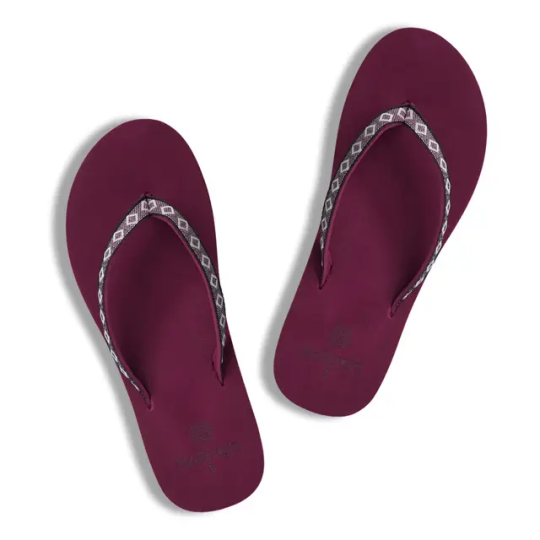
Orthopedic arch slippers are designed to offer excellent foot support and all-day comfort, making them perfect for daily use. With built-in arch support, they help maintain proper alignment and reduce strain on the feet, ankles, and lower back. Ideal for flat feet, plantar fasciitis, or long hours on your feet. Order now and get 10% off every pair: https://bit.ly/4lyWgUf
1 note
·
View note
Text
a brief update on life and the blog (contains medical stuff)
If you don't want to read, I kindly ask for your prayers :)
Brief introduction: my name is Liv, I'm 27, and I'm an orthopedic/ocology nurse in Florida. Diagnosis with an unknown cause of myocarditis (heart inflammation) in August 2023.
I was expected to make a full recovery within 2 months. January rolls around, I'm still sick. April rolls around, I'm even sicker and they finally test me for an autoimmune disease. Let's roll to today where in 3 days they'll finally give me a diagnosis and treatment for lupus induced myocarditis. Long story short, I have a severe autoimmune condition that is attacking and actively killing my heart.
I'll save the details, but over the last nearly 11 months, I've been in the hospital 6 times and admitted for 2 of them with no answers. This last one was 3 days and I underwent a cardiac cauterization, which is something they do for people who have heart attacks. Luckily, there doesn't seem to appear to be any permanent damage despite my heart levels being the highest I've ever seen in my career.
Bad news is that over the last year, I've suffered intense chest pain that makes it difficult to breathe, my ankles are swelling, and I have no energy and life just overall sucks. I surprisingly never stopped working. However, being a bedside nurse taking care of actively dying cancer patients is just mentally exhausting and one week ago, I finally hit the breaking point and sobbed in the bathroom before my shift started. I still don't have the details, but I've requested an extended leave of absence from work.
In 3 days, I'll finally have an answer. My doctor already warned me that treatment will be intense. I'll be undergoing chemotherapy.
But, hey, guess what? I'm an oncology nurse and guess what I do for a living?
This last year has been exhausting. It's been the worst. I'm very blessed to say that I've never suffered from any mental illness or depression, but in the last three months I really think that's what I've felt. Nothing makes me happy that used to, I've stopped cleaning my condo (and I'm a minimalist who hates clutter btw), my eating habits are trash, I can't exercise since my heart gives out, and I've completely isolated myself from my friends and my wonderfully supportive family. Every time i do go out, I just bring them down, too.
And guess who bought a condo literally one week before this all went down? I'm not in a safe financial position to stop working for a long time, but I can for a brief time. I'm thankful to be where I am in the sense of good healthcare and a small emergency fund.
I guess what I'm trying to say is that my life this last year has been bad, but the last three months have been the worst, so my activity on this blog has been sporadic and inconsistent. I know my writing quality has gone down; I can't apologize for getting sick, just know that soon I can have some answers and recover to get back to where I was.
My faith has taken the hardest hit. I am a firm Christian and I believe in the power of prayer. I'd really appreciate a prayer from everyone, even if you don't believe, it would still mean a lot.
6 notes
·
View notes
Text
Jain Orthovision: Advancing Orthopedic Care in Kota
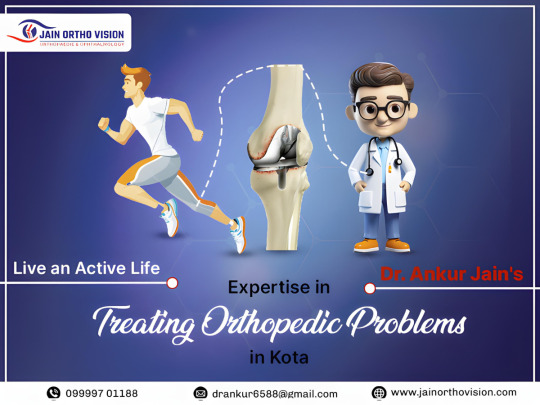
Jain Orthovision stands at the forefront of orthopedic care in Kota, led by a team of dedicated specialists committed to providing exceptional treatment for a wide range of musculoskeletal conditions. As the first orthopedic center in Kota, we take pride in our leadership role and our ability to offer comprehensive care that addresses the diverse needs of our patients.
Expertise in Orthopedic Treatments and Procedures
Our orthopedic specialists at Jain Orthovision are highly skilled in diagnosing and treating various orthopedic conditions, including joint disorders (such as knee, hip, shoulder, elbow, and ankle issues), spine and neck problems, sports injuries, arthritis, osteoporosis, congenital deformities, trauma, and fractures. We offer a spectrum of advanced treatments and procedures tailored to meet the unique needs of each patient:
Joint replacement surgeries (knee, hip, shoulder)
Arthroscopic surgeries
Spinal surgeries (discectomy, laminectomy, fusion)
Minimally invasive procedures
Trauma and fracture management
Pediatric orthopedics
Orthopedic oncology
Regenerative medicine (stem cell therapy, PRP)
Up-to-Date Facilities and Avant-Garde Technology
At Jain Orthovision, we are committed to maintaining state-of-the-art facilities and employing cutting-edge technology to enhance patient care:
Advanced diagnostic imaging including MRI, CT scans, and digital X-rays for accurate diagnosis.
Operating theaters equipped with laminar airflow technology to ensure sterile conditions during surgeries.
Navigation and robotic systems integrated with computer technology to advance surgical precision.
Comprehensive physical therapy and rehabilitation services.
Orthotic and prosthetic facilities to support patients in their recovery and rehabilitation process.
Patient-Centered Approach and Customized Care
Central to our practice is a patient-centered approach that prioritizes individual health and well-being. We understand that each patient is unique, and our orthopedic doctors in Kota take the time to listen, assess, and develop personalized treatment plans. Whether you require joint replacement or specialized orthopedic care, we are dedicated to providing compassionate support and guidance throughout your journey to recovery.
Research and Continuous Improvement
At Jain Orthovision, we are driven by a commitment to research and continuous improvement in orthopedic care. Our specialists actively engage in clinical research, collaborate with leading academic institutions, and embrace innovative technologies to advance orthopedic treatments and techniques. This dedication ensures that our patients receive the most effective and evidence-based care available.
Conclusion
Jain Orthovision is more than a leading orthopedic center—it is a beacon of excellence in musculoskeletal health care in Kota. Through our expertise, advanced technology, patient-centric approach, and commitment to research, we strive to deliver unparalleled orthopedic care that enhances the quality of life for our patients.
What types of orthopedic conditions does Jain Orthovision treat? Jain Orthovision specializes in treating a wide range of orthopedic conditions, including joint disorders (knee, hip, shoulder, elbow, ankle), spine and neck problems, sports injuries, arthritis, osteoporosis, congenital deformities, trauma, and fractures.
What orthopedic treatments and procedures are available at Jain Orthovision? The center offers comprehensive orthopedic care, including joint replacement surgeries (knee, hip, shoulder), arthroscopic surgeries, spinal surgeries (discectomy, laminectomy, fusion), minimally invasive procedures, trauma and fracture management, pediatric orthopedics, orthopedic oncology, and regenerative medicine (such as stem cell therapy and PRP).
Does Jain Orthovision use advanced technology for diagnosis and treatment? Yes, Jain Orthovision employs advanced diagnostic imaging technologies such as MRI, CT scans, and digital X-rays to accurately diagnose orthopedic conditions. The center also utilizes operating theaters with laminar airflow for sterile conditions during surgeries and incorporates navigation and robotic systems to enhance surgical precision.
How does Jain Orthovision ensure personalized care for patients? Jain Orthovision adopts a patient-centered approach, where each patient receives personalized attention and treatment plans tailored to their specific condition and needs. The orthopedic doctors at Jain Orthovision prioritize listening to patients, conducting thorough assessments, and developing customized treatment strategies.
What role does research play at Jain Orthovision? Research and continuous improvement are integral to Jain Orthovision's practice. The center's specialists actively engage in clinical research, collaborate with academic institutions, and stay updated with the latest advancements in orthopedic treatments and techniques. This commitment ensures that patients benefit from evidence-based care and innovative solutions.
visit : https://jainorthovision.com/
Address NIRAMAYA Clinic, 1-A-4, Sheela Choudhary Rd, near Alok Hospital, New Rajeev Gandhi Nagar, VIP Colony, Talwandi, Kota, Rajasthan 324005
Contact +91 99997 01188
Email [email protected]
1 note
·
View note
Text
What is Sciatica?
Stem Cell Therapy for Orthopedic Disorder in India | Affordable, Safe, and Quality Treatment | Stem Cell Therapy For Orthopedic Patients | How Stem Cells Can Help Treat Orthopedic Disorder? | Stem cell therapy for Orthopedic Disorder | Stem Cell Therapy for Osteoarthritis in India |
At Stem Cell Care India, Orthopedic Disease Treatment includes a unique combination of therapies including #stem_cell_therapy, #supportive_therapy, occupational therapy, #specializeg_growt_factor, and multivitamin injection, and #physiotherapy. The duration of treatment is based on the patient’s severity and state and it ranges from 3-4 days.
Orthopedic problems are disorders linked to the musculoskeletal system. They might involve the bones, muscles, cartilage, connective tissues, or joints. Orthopedic problems might be pathological like fracture, dislocation, and tumors; degenerative like osteoarthritis, and osteoporosis, or inflammatory autoimmune disorders like rheumatoid arthritis, gout, systemic lupus erythematosus (SLE). Long-term joint pain, and muscle, or tendon pain can be exasperating. These pains lead to some of the most common musculoskeletal complications and they can be because of strains, sprains, and overuse. The pain is most common on the shoulders, back, knees, hip, and ankles. It might be a worthy idea to seek medical support when the pain takes a bit longer to subside so you can decrease the chances of it developing into a more serious issue.
Orthopedic stem cell treatment deals with anything that is concerned with muscles, ligaments, and joints via stem cells. Any disorders that affect these three portions of the body involve an orthopedic surgeon. Some of these ailments include injuries and sicknesses of the knee, dislocated shoulders, torn cartilages, or foot pain.
To know more about Osteoarthritis and its treatment at Stem Cell Care India, please visit
Website- https://www.stemcellcareindia.com/
Facebook- https://www.facebook.com/StemCellCare...
Instagram- https://www.instagram.com/stemcellcar...
Twitter- https://twitter.com/StemCellCare
Email id- [email protected]
Ph no- +91 8743024344
Working Hours Monday –
Saturday 8.00 AM to 8.00 PM
Consultation Hours
10:00 AM – 2:00 PM
3:00 PM – 7:00 PM
#orthopedicstemcelltherapyinIndia#stemcelltherapyforosteoarthritis#orhtopedicdisease#osteoarthritistreatment#stemcells#specializeg_growt_factor#supportive_therapy#beststemcellcenterinindia#stemcelltreatment#exosometherapy#dietconsultant#physiotherapysession#beststemcellhospitalindelhi#orthopedics
1 note
·
View note
Text
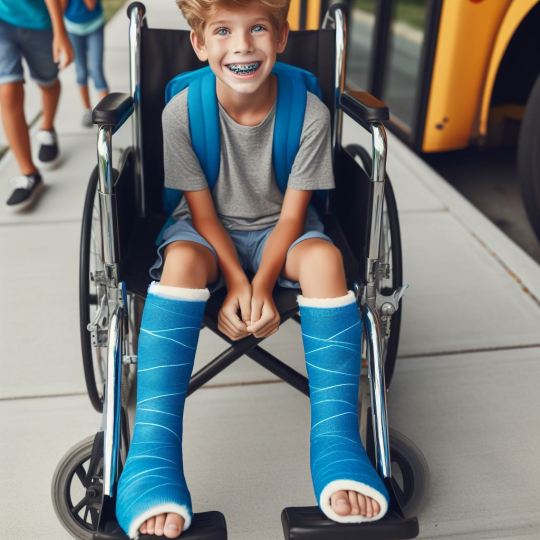
Asher stared down at his legs, both propped up on a cushion in the school bus. Each was wrapped in a bright blue fiberglass cast that ended just below the knees. His bare toes stuck out at the ends—ten pink, clean toes that moved slightly with each bump in the road. His sneakers were in his backpack. He didn’t need them now. He couldn’t walk anyway.
Just five days ago, everything had been normal. Asher had stayed the night at his friend Micah’s house. They had finished dinner and started messing around with Micah’s new fold-up treadmill. It had a safety bar and a digital screen, and Micah’s older brother had dared them to try walking backward on it while it was set to the slowest speed.
At first, it was funny. They laughed, took turns recording videos, and joked about uploading them later. Asher stepped on carefully when it was his turn. He held the side rails and walked backward while facing the back of the room. Then Micah, trying to be funny, tapped the speed up button twice.
The belt sped up faster than expected. Asher lost his balance almost instantly. His legs slid under him and both feet twisted as he hit the belt hard. The machine didn’t stop—his legs were dragged back, and his ankles got wedged awkwardly between the moving belt and the plastic edge of the frame. He shouted in pain.
Micah yanked the emergency cord. The machine stopped, but Asher didn’t get up. His ankles felt like they were burning from the inside. Micah’s mom called 911 immediately. The paramedics arrived and loaded Asher onto a stretcher. His ankles were already swollen.
At the hospital, the X-rays showed the damage clearly—both ankles were fractured. The doctor called it “a rare and severe bilateral ankle injury.” Surgery wasn’t needed, but both legs would be immobilized in short casts for at least six weeks. Asher had sat in silence while the orthopedic techs padded his legs, wrapped them in wet fiberglass, and formed the blue casts carefully around his ankles and lower calves. His toes stuck out of each one. The tech checked for circulation, tapped each toe, and told him to keep an eye out for changes in color or temperature.
He spent the next two days in bed with his legs elevated. A wheelchair arrived from a medical supply company, and the school district arranged transportation. He wasn’t ready to go back—but it was Monday, and he didn’t want to fall too far behind.
Now he was on the bus, rolling toward school for the first time since the accident. The driver greeted him politely but didn’t ask questions. Asher appreciated that. The ramp lifted him into place, and his wheelchair was secured with straps. His legs were still, each cast supported on a foam wedge. His toes pointed slightly outward from the ends of the casts. He had trimmed his toenails the night before and cleaned his feet with a warm cloth. There wasn’t much else to do.
At school, a staff member met him at the entrance. Students passing by stared a little. Some noticed the casts. Others noticed his bare feet, toes visible and immobile. A few people whispered. Someone asked what happened, and Asher just said “treadmill accident” before wheeling away.
In class, desks had been moved to give him space. He couldn’t put weight on either leg, so he stayed seated all day. The casts were hard and snug. He could wiggle his toes, but that was it. When the air conditioning kicked on, his toes felt cold. When the sun came through the window, they warmed up fast. It was strange being so aware of that part of his body all the time.
At lunch, a friend helped push his chair. One classmate joked that his toes looked like they were “on vacation.” Asher laughed once but didn’t respond. They sat at the end of a table. A teacher came by to ask if he needed help eating. He said no. His arms worked fine—it was just his legs that didn’t.
The school day dragged. His feet started to itch under the casts, especially around the heels. The nurse gave him a tool he could use to gently reach inside and scratch. She also reminded him not to shove anything too deep or sharp into the openings.
When the bus pulled up that afternoon, he was ready to go home. The ramp lowered. He rolled forward. The driver clicked the straps into place. Asher leaned back, legs stretched out in front of him, two blue casts locked in place with nothing but his exposed toes showing movement.
As the bus rolled away, he thought again about the moment everything changed—just one misstep, one prank, and now he was stuck like this for over a month. Still, he was back at school, doing what he could. That mattered.
2 notes
·
View notes
Text
Best Hospital For Knee Replacement In Mumbai
Varicose veins or Spider veins often look swollen, enlarged, blue/dark purple veins. And they tend to occur when some faulty valves cause the vein to pool blood or cause the blood to flow in the wrong direction.
Orthopedic surgery in Mumbai is super helpful for fixing bone and joint problems. When things go wrong with our bones, muscles, or joints, it can make it tough to move around and do stuff. Sometimes, diseases or injuries can make things worse and even put our lives at risk. Osteoarthritis is a type of joint problem that’s common among adults nowadays.
But hey, good news! Best Hospital For Knee Replacement In Mumbai have gotten really advanced. They can now prevent, diagnose, and treat bone and joint issues for people of all ages. Plus, surgeries have become less invasive, which means they don’t mess up your body as much. And the implants they use are better quality and long lasting. So, if you’re dealing with bone or joint troubles, an orthopedic surgeon in Mumbai can help you out big time!
Orthopedic Treatment In Mumbai
The various treatments for orthopedic problems include:
Joint replacement services In Mumbai:Advanced joint replacement treatment in Mumbai offers hope to those suffering from conditions like osteoarthritis, rheumatoid arthritis, infections, and injuries. Skilled ortho surgeons in Mumbai from the House of Doctors utilize advanced techniques and materials to replace damaged cartilage and structures in joints like the shoulder, elbow, hip, and knee. This procedure not only relieves pain but also enables swift recovery, ensuring patients regain mobility and improve their quality of life. With expert care and advanced technology, joint replacement treatment in Mumbai provides effective solutions for individuals seeking relief from joint issues.
Arthroscopy and sports orthopedics services In Mumbai:Arthroscopy is the preferred orthopedic surgery for treating degenerative and traumatic conditions of the shoulder, elbow, hip, knee, and ankle joints. This minimally invasive procedure uses keyhole incisions, allowing surgeons to view and treat joint pathologies with the help of an arthroscope and specialized instruments. For those seeking the best ortho surgeon in Mumbai, HOD offers top-notch care with a dedicated sports physiotherapy department. Their team ensures a complete return to normalcy, a quicker return to sports, and continued support for all patients. For sports orthopedics in Mumbai, HOD is the premier choice, providing comprehensive treatment and rehabilitation for athletes and active individuals.
What is a Knee Joint Replacement?
A knee joint replacement, also known as knee arthroplasty, is a surgical procedure in which damaged or worn-out surfaces of the knee joint are replaced with artificial components. This surgery is typically recommended for individuals suffering from severe arthritis or significant knee injuries that cause chronic pain and impair mobility. The goal of the procedure is to alleviate pain, restore function, and improve the quality of life.
If you are considering this procedure, finding an experienced knee replacement surgeon in Mumbai is crucial. Mumbai is home to some of the best orthopedic specialists who utilize advanced surgical techniques to ensure optimal outcomes. Additionally, choosing a reputable knee replacement hospital in Mumbai can make a significant difference in your recovery. These hospitals offer state-of-the-art facilities, comprehensive pre-operative and post-operative care, and specialized rehabilitation programs to support a smooth and speedy recovery. With the expertise of a skilled knee replacement surgeon in Mumbai and the support of a top-tier knee replacement hospital in Mumbai, patients can look forward to regaining their mobility and enjoying a pain-free life.
What causes Knee Pain?
Knee pain is a common complaint that can arise from a variety of causes, affecting individuals of all ages. The primary reasons for knee pain include injuries, mechanical problems, types of arthritis, and other conditions.
Injuries:- Knee injuries can result from sports, accidents, or falls. Common injuries include ligament tears (such as ACL injuries), meniscus tears, fractures, and patellar tendinitis.
Mechanical Problems:- Conditions such as a dislocated kneecap, iliotibial band syndrome, or hip or foot pain can cause knee pain by altering the way you walk, leading to strain on the knee joint.
Arthritis:- There are different types of arthritis that can affect the knee. Osteoarthritis, the most common type, involves wear-and-tear damage to the knee’s cartilage. Rheumatoid arthritis is an autoimmune condition that can also cause knee pain. Other forms include gout and septic arthritis.
Other Conditions:- Conditions such as bursitis (inflammation of the bursae), Baker’s cyst, or infections can also lead to knee pain.
For those with severe knee pain that does not respond to conservative treatments, knee replacement surgery might be recommended. Knee replacement surgery in Mumbai is a highly advanced procedure available at numerous top medical facilities. The best hospital for knee replacement in Mumbai offers state-of-the-art technology, skilled surgeons, and comprehensive care to ensure the best outcomes for patients.
If you are suffering from chronic knee pain, or restricted knee movements, consulting with a specialist at the best hospital for knee examination in Mumbai can help determine the appropriate treatment plan. Knee replacement surgery in Mumbai has a high success rate and can significantly improve the quality of life for those suffering from debilitating knee pain.
Cost Of Knee Replacement Surgery In Mumbai
The total knee replacement surgery cost in Mumbai can vary significantly depending on several factors, including the hospital, the surgeon’s expertise, the type of implant used, and the specifics of the patient’s condition. While it is challenging to provide a specific price without a detailed consultation, understanding the general factors that influence the cost can help you make an informed decision.
Factors Affecting the knee replacement surgery cost mumbai:
Hospital Choice:The reputation and facilities of the hospital play a significant role in determining the knee replacement surgery cost mumbai . Premium hospitals with state-of-the-art infrastructure and advanced technology may charge higher fees compared to smaller clinics.
Surgeon’s Expertise:Experienced knee replacement surgeons in Mumbai, particularly those with a proven track record of successful surgeries, may charge more for their services. The surgeon’s skill and experience can significantly impact the overall cost.
Type of Surgery:The complexity of the surgery, whether it is a total knee replacement or a partial knee replacement, can also influence the knee replacement surgery cost in Mumbai. Minimally invasive techniques might have different cost implications compared to traditional open surgery.
Implant Quality:The type and quality of the implant used during the surgery are crucial factors. High-quality, long-lasting implants tend to be more expensive but can provide better outcomes and longevity.
Post-Operative Care and Rehabilitation:Comprehensive post-operative care, including physiotherapy and rehabilitation services, is essential for a successful recovery. These services are often included in the overall cost of knee replacement surgery in Mumbai.
Additional Medical Costs:Pre-operative tests, medications, hospital stay, and any unforeseen medical needs can also contribute to the total knee surgery cost in Mumbai.
Medical Insurance:Patients with medical insurance may find that their knee replacement cost in Mumbai is significantly reduced, depending on their policy’s coverage. It’s essential to check with the insurance provider to understand the extent of coverage for knee replacement surgery.
When considering knee replacement surgery, it is essential to discuss all these factors with your healthcare provider to get a clear understanding of the potential costs involved. By choosing a reputable hospital and an experienced surgeon, you can ensure that you receive high-quality care and achieve the best possible outcomes.
0 notes
Text
Comprehensive Guide to Shoulder and Headache Treatments in Hornsby
If you're experiencing persistent shoulder pain, limited mobility, or headaches that disrupt your daily routine, seeking professional treatment is essential. Hornsby offers a range of specialized therapies tailored to address these common issues effectively. Whether you’re dealing with a frozen shoulder, joint instability, or headaches, understanding your options can help you regain comfort and function.
Frozen Shoulder Treatment in Hornsby
Frozen shoulder, medically known as adhesive capsulitis, is a condition characterized by stiffness and pain in the shoulder joint. It typically develops gradually and can significantly impair movement, making simple tasks like dressing or reaching for objects challenging.
The Frozen Shoulder Treatment in Hornsby options focus on reducing pain, restoring range of motion, and preventing recurrence. Initial management often includes physical therapy, where targeted exercises help loosen the shoulder joint and improve flexibility. Modalities such as ultrasound therapy or joint mobilization techniques are also common to alleviate pain and promote healing.
In more severe cases, corticosteroid injections may be administered to reduce inflammation. If conservative treatments are ineffective, physicians in Hornsby might recommend minimally invasive procedures like shoulder arthroscopy, which allows for precise removal of scar tissue and adhesions.
A tailored treatment plan is crucial because frozen shoulder typically involves three phases: the freezing phase, frozen phase, and thawing phase. Early diagnosis and intervention can shorten the duration of symptoms and improve outcomes. Consulting with a specialist in Hornsby ensures that your treatment is personalized to your specific condition and needs.
Joint Instability Treatment in Hornsby
Joint instability occurs when the tissues holding the joint together become stretched or torn, leading to a sense of looseness or giving way. This condition can result from injuries, repetitive strain, or degenerative changes and often affects the shoulder, knee, or ankle joints.
Joint Instability Treatment Hornsby involves a combination of conservative and surgical options. Initially, physical therapy plays a vital role in strengthening the muscles around the joint, providing better support and stability. This includes targeted strengthening exercises, proprioception training, and activity modification.
For cases where conservative management does not yield sufficient improvement, surgical interventions such as ligament repair or reconstruction may be necessary. Arthroscopic techniques allow for minimally invasive procedures that restore joint stability with less downtime.
Preventing recurrent instability requires a comprehensive approach, including activity modification, bracing, and sometimes joint stabilization procedures. A sports medicine specialist or orthopedic surgeon in Hornsby can assess your condition thoroughly and recommend the most effective treatment strategy.
Headaches Treatment in Hornsby
Headaches are a common ailment that can significantly impact quality of life. They may be caused by various factors, including tension, migraines, or underlying medical conditions. Proper diagnosis is crucial to determine the most effective treatment approach.
Headaches Treatment Hornsby encompasses a wide range of therapies. For tension headaches, posture correction, stress management techniques, and physical therapy focusing on neck and shoulder muscles can provide relief. Migraine sufferers might benefit from medication, lifestyle adjustments, and identifying triggers through detailed consultations.
In some cases, headaches are linked to cervical spine issues or joint problems, which can be addressed through physical therapy or chiropractic care. When headaches are severe or persistent, imaging studies may be conducted to rule out other underlying causes such as vascular abnormalities or neurological conditions.
A multidisciplinary approach, involving neurologists, physiotherapists, and pain specialists in Hornsby, ensures comprehensive care tailored to each patient's needs. Lifestyle modifications, medication management, and alternative therapies like acupuncture can also be part of an effective headache treatment plan.
Why Choose Professional Care in Hornsby?
Hornsby is home to highly qualified healthcare providers specializing in musculoskeletal and neurological conditions. Their expertise ensures that conditions like frozen shoulder, joint instability, and headaches are diagnosed accurately and treated effectively. Early intervention is key to preventing complications and promoting quicker recovery.
Whether you are seeking frozen shoulder treatment Hornsby, joint instability treatment Hornsby, or headaches treatment Hornsby, local clinics and specialists are equipped with the latest techniques and technologies to provide optimal care.
0 notes